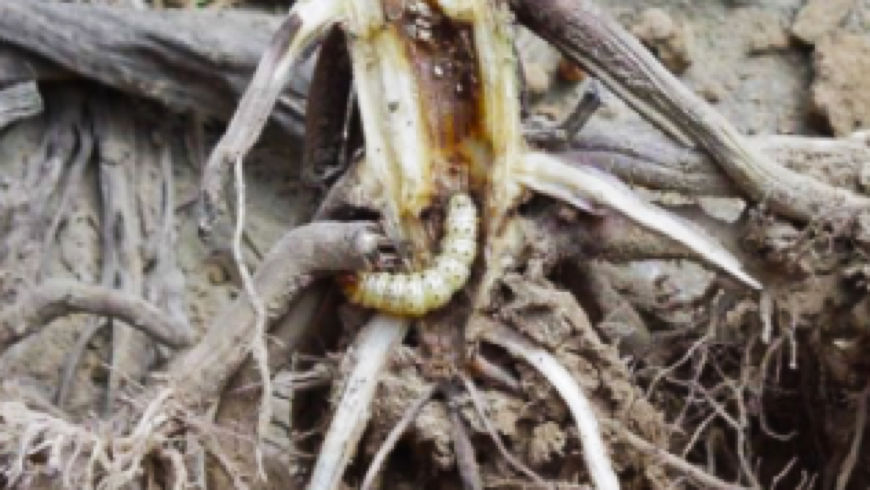A Guide to Corn Insect Damage
October 23, 2023

Cornfields face numerous threats throughout the season. Those threats include the various insects that can cause significant damage to crops. Identifying these pests and understanding the damage they inflict is an important step in protecting your yield potential. In this article, we will explore the most common corn insects, the types of damage they cause, and how Bayer Traits & Systems offers proven solutions to combat these threats.
Top Corn Insects: Culprits of
Crop Damage
Corn Rootworm (CRW)
Corn rootworm can be found in many regions of the Corn Belt, causing severe damage to crops. Corn rootworm larvae feed primarily on corn roots, typically in June and July.
*Corn rootworm larvae are white with a brown head and have a dark plate on the top side of their tail section. They are slender and about 1/2 inch long when fully grown.
Identifying Corn Rootworm Damage
Damage to roots can appear as feeding scars, roots that appear tunneled into, or roots that are chewed back to the base of the plant or crown.
Moderate root damage may result in lodging and cause problems at harvest.
When roots are pruned by corn rootworm, water and nutrient uptake can be hindered, which can affect yield.

Taking Action
Performing root digs can help you to determine the severity of corn rootworm damage in your fields by using the root node injury scale. It is recommended to scout for adult beetles using yellow sticky traps to gauge the level of pressure a farmer might have the following year.
Trait Recommendations:
Black Cutworm
Black cutworm is one of the most common cutworm species in the corn-growing area. These above-ground pests are known to cause “dead heart” in corn plants.They usually cut young corn plants (early vegetative stages) at the soil surface or burrow into larger plants, affecting the overall health of the crop.
*Black cutworm larvae can be identified by their black/pale-gray appearance and grainy-feeling skin.
Identifying Black Cutworm Damage
- Black cutworm feed on corn, which then likely wilts and dies.
- When soil moisture is adequate, the larvae climb to just above the soil
surface at night to feed and cut off the young plants at the base. - Severe black cutworm damage typically occurs in patches within a field.

Taking Action
Since black cutworm targets corn early in the growing season, timely scouting is key.
Trait Recommendations:
Fall Armyworm (FAW)
Fall armyworm appears from mid-July through harvest, damaging corn at various stages of development by feeding on leaf or ear tissues. This pest can cause extensive defoliation, affecting the plant's ability to produce yield.
*Fall armyworm larvae can be identified by the inverted Y shape on the top of their heads. Larvae vary from light tan or green to almost black.
Identifying Fall Armyworm Damage
Young fall armyworm larvae feed on leaves in the whorl stages early in the season. This damage manifests as ragged edges or shot holes in the leaves.
Fall armyworm larvae also feed by burrowing through the husk on the side of the ear, unlike corn earworm.
Larvae also enter at the base of the ear, feeding along the sides and may tunnel into the cob.

Taking Action
Scouting for fall armyworm can be difficult. Early damage appears as "windowpane" feeding and shot holes in leaves. If whorl damage exists, pull some whorls and unroll the leaves to make larval counts.
Trait Recommendations:
True Armyworm (TAW)
True armyworm is a migratory pest that consumes the leaf tissue of both early and late vegetative corn stages. Feeding occurs earlier in the season than fall armyworm feeding and can cause damage in seedlings and whorl stage corn.
*True armyworm larvae have dull orange stripes that run the length of their body.
Identifying True Armyworm Damage
True armyworm feeding typically begins on the lower leaves of the corn plant.
Larvae feed near leaf edges and will consume all of the leaf except for the tougher midrib on later leaf stage corn.
Damage often looks ragged with large pieces of tissue removed.

Taking Action
True armyworm can cause extensive damage to seedling corn plants. No-till fields or fields that had a cover crop should be scouted in May and June. When scouting, check field borders and areas with current or past high grass weed pressure.
Trait Recommendations:
Corn Earworm (CEW)
Corn earworm has one of the widest host ranges of any insect pest, with over 15 cultivated plant hosts. They migrate with winds and storms from southern states, with moths laying eggs in corn and other host crops.
*Corn earworm larvae grow to be 1 1/2 inches long. The larval stage can occur in a range of colors, from green to dark brown.
Identifying Corn Earworm Damage
Larvae feed on leaves, the whorl and within ears. Corn ears are the favored locations for corn earworm feeding.
Ear damage is characterized by extensive excrement at the ear tip.
Ear feeding may create a potential opportunity for fungal pathogens to enter.

Taking Action
Using pheromone traps is the most effective way to scout for corn earworm moths. Scouting for eggs immediately after traps catch moths can help to indicate the potential damage for a certain crop.
Trait Recommendations:
Control
Control or suppress
European Corn Borer
This above-ground pest causes damage to leaves, stalks, and ears of corn. The larvae bore into the stalk, disrupting the flow of nutrients and water, which can lead to reduced yield. The tunneling can also make the plant susceptible to breaking off, thus affecting the harvest. Effective management of this pest is crucial to minimize crop losses.
*Larvae can be identified by their dark-brown/black head and dirty-white-colored skin (often having a pinkish tinge) with two brown spots on each segment of the body.
Identifying European Corn Borer Damage
Larvae damage can cause leaves to break at the point of borer entry.
Feeding typically produces a random shot hole damage pattern on leaves.
As larvae move down the stalk and bore into it, they leave behind a sawdust-like excrement called frass.
Second-generation borers may cause stalk or tassel breakage and/or bore into the ear shanks, potentially resulting in ears to drop off.

Taking Action
Moths can be detected in traps (blacklight or pheromone-baited). Insecticides can provide effective control of the European corn borer if properly timed. Cultural practices such as early planting and harvesting can reduce the number of insecticide treatments needed.
Trait Recommendations:
Southwestern Corn Borer (SWCB)
This pest mainly affects southern states and causes damage similar to that caused by European corn borer. They can also girdle the stalk near the crown of the plant.
*Southwestern corn borer larvae can be identified by their brown head and dull white bodies with a pattern of raised black spots.
Identifying Southwestern Corn Borer Damage
First-generation southwestern corn borer larvae initially feed on succulent tissues within the corn whorl. As the damaged leaves unfurl, they have a shot hole appearance.
Elongated stripping or “windowpane” feeding of leaves is another sign of southwestern corn borer damage.
After feeding on leaf tissues, larvae will bore into the stalks where they will cause tunneling.

Taking Action
Early planted corn usually escapes significant girdling damage. Timing is critical for in-season control. Larvae can be effectively controlled when they are feeding on leaves, but they cannot be controlled once they enter the stalk.
Trait Recommendations:
Western Bean Cutworm (WBC)
Western bean cutworm is an ear-feeding pest that feeds on tassels, silks, husks and kernels. Once inside the ear, they become challenging to manage. Identifying this pest and employing appropriate measures are crucial to protecting your crop.
*Adult larvae are about 1 1/2 inches long and have two black squares above their head — which can be used to distinguish western bean cutworm larvae from corn earworm larvae.
Western bean cutworm can also be identified by egg masses on the upper surface of corn leaves.
Identifying Western Bean Cutworm Damage
Mature larvae feed on the ear tip and tunnel into the side of the ear to access the kernels.
Most feeding is concentrated on the ear, with emergence holes being visible at harvest.
Subsequent mold and fungal infections can occur as a byproduct of larvae waste.

Taking Action
Scouting for western bean cutworm moths can be done using either pheromone traps near cornfields or a developmental model that predicts moth emergence. Timing should be focused on the corn developmental stage in mid-June through July. Scouting for egg masses or young larvae on the leaves is recommended to help properly time an insecticide application before larvae enter the ear.
Trait Recommendations:
Proactive Protection
Corn insects pose significant challenges for farmers, threatening crop yield and profitability. Thankfully, there are variety of trait options available to you that help minimize the threat. Take our simple quiz to find which trait best fits your specific needs.